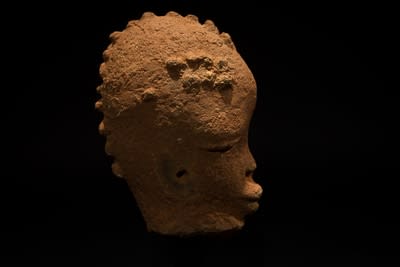Terracotta Nok Head, 1000 BCE - 200 BCE
20.3 x 7.6 x 10.2 cm
8 x 3 x 4 in
8 x 3 x 4 in
JL.020
Further images
Comparatively little is known of the Nok culture, which is defined largely on the basis of its superb terracotta artworks. Flourishing between 900 BC and 200 AD, the Nok style...
Comparatively little is known of the Nok culture, which is defined largely on the basis of its superb terracotta artworks. Flourishing between 900 BC and 200 AD, the Nok style is, in fact, an agglomeration of similar traditions that flourished in western and central Nigeria. While there are different stylistic categories, these have little social significance as finds of in-situ Nok material culture are almost unheard-of. Stray archaeological discoveries have confirmed that the Nok culture is, in fact, a myth – the Nok is a tradition, a style of manufacture that was adopted by different Iron-Age agriculturally- based communities that in fact had widely varying cultures in all other respects. What does unite the trends, however, is a series of outstanding ceramic sculptures, which constitute the most sophisticated and formalized early African artistic tradition outside Egypt.
It should be noted that the sophistication of these terracottas makes some scholars believe that they sprang from a hitherto undiscovered ceramic tradition. Technically, they are very unusual because of the manner in which coiled and subtractive sculpting methods were used to capture likenesses. Aesthetically, they are both naturalistic and expressionist, with highly distinctive elongated forms, triangular eyes, pierced pupils/nostrils and elaborate hairstyles. Substyles of the Nok tradition include the Classical Jemaa Style, the Katsina Ala Style (elongated heads) and the Sokoto Style (elongated monobrow foreheads, lending a severe expression to the face) and random variants such as the Herm Statues of Kuchamfa (simplified cylindrical figures topped with normal heads) and the “standard” three-dimensional standing figures, which subscribe to the Jemaa style. The function of the art is unclear, although the care with which they are executed has led some to claim they represent nobility, perhaps ancestors to which obeisance and sacrifices were offered.
With the style of manufacture is not conventional for any of the Nok subgroups and appears a fusion of the two. The restrained hairstyle suggests it may be Katsina. The face is slightly elongated however the eyes are pierced semicircles under a ridged shelf protruding over both eyes (a characteristic of Sokoto). On balance, the piece displays the many traits that are aligned with the Katsina group, including nugatory features/limbs, and simple hair/headwear, although it must be said that the precise attribution is hampered by the uniqueness of the piece and the enigmatic expression. Most Katsina faces are refined, tranquil and smooth (if female) or bad-tempered and bearded (if male). This tentative attribution would place the piece at the end of the 1st millennium BC and the first centuries of the 1st millennium AD, however, the potent enigmatic qualities of this piece, which wield so much power, mean that the piece could conceivably be from any period of Nok production.
It should be noted that the sophistication of these terracottas makes some scholars believe that they sprang from a hitherto undiscovered ceramic tradition. Technically, they are very unusual because of the manner in which coiled and subtractive sculpting methods were used to capture likenesses. Aesthetically, they are both naturalistic and expressionist, with highly distinctive elongated forms, triangular eyes, pierced pupils/nostrils and elaborate hairstyles. Substyles of the Nok tradition include the Classical Jemaa Style, the Katsina Ala Style (elongated heads) and the Sokoto Style (elongated monobrow foreheads, lending a severe expression to the face) and random variants such as the Herm Statues of Kuchamfa (simplified cylindrical figures topped with normal heads) and the “standard” three-dimensional standing figures, which subscribe to the Jemaa style. The function of the art is unclear, although the care with which they are executed has led some to claim they represent nobility, perhaps ancestors to which obeisance and sacrifices were offered.
With the style of manufacture is not conventional for any of the Nok subgroups and appears a fusion of the two. The restrained hairstyle suggests it may be Katsina. The face is slightly elongated however the eyes are pierced semicircles under a ridged shelf protruding over both eyes (a characteristic of Sokoto). On balance, the piece displays the many traits that are aligned with the Katsina group, including nugatory features/limbs, and simple hair/headwear, although it must be said that the precise attribution is hampered by the uniqueness of the piece and the enigmatic expression. Most Katsina faces are refined, tranquil and smooth (if female) or bad-tempered and bearded (if male). This tentative attribution would place the piece at the end of the 1st millennium BC and the first centuries of the 1st millennium AD, however, the potent enigmatic qualities of this piece, which wield so much power, mean that the piece could conceivably be from any period of Nok production.











